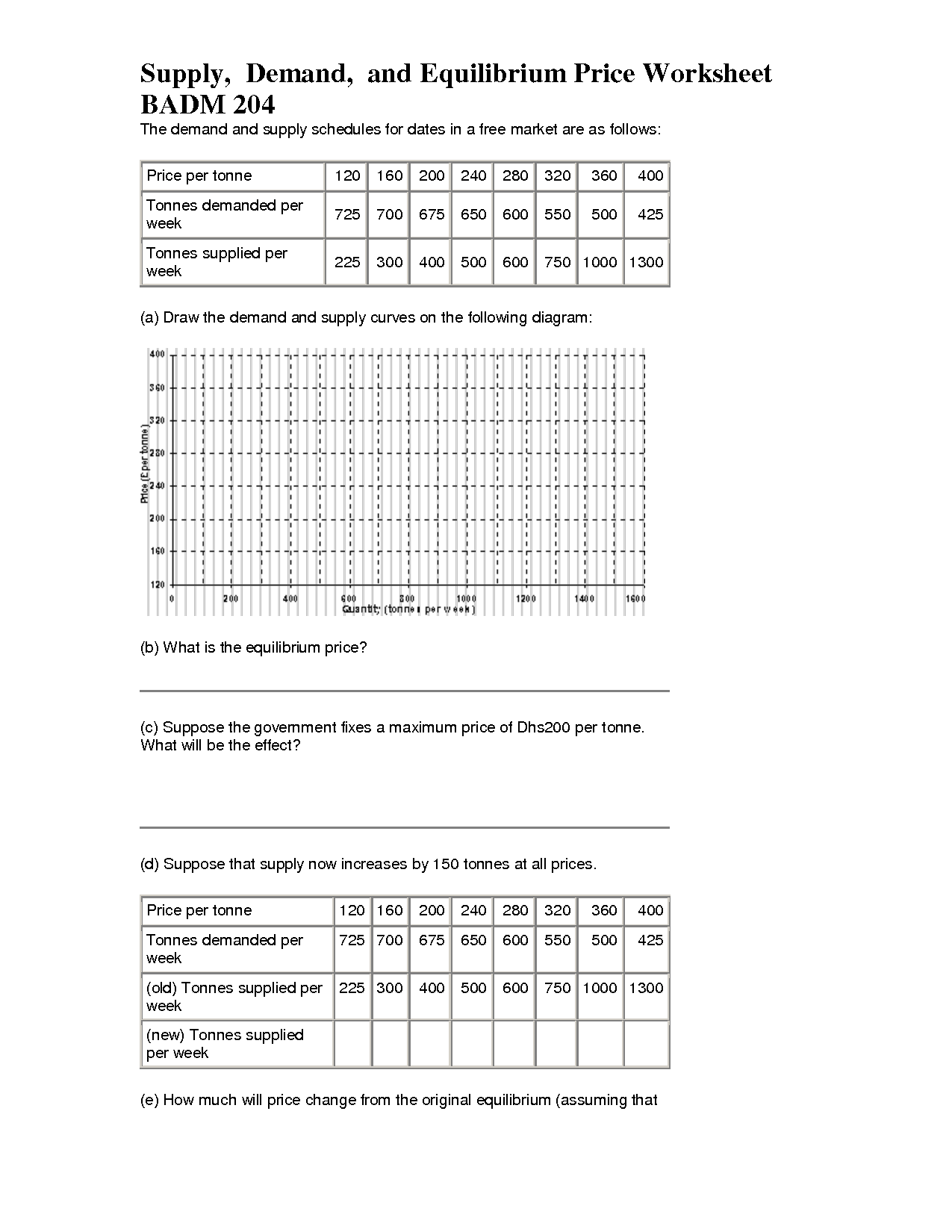Economics Worksheets Supply
If you're an economics student looking for well-designed and comprehensive worksheets to enhance your understanding of supply, you've come to the right place. These worksheets focus on the entity and subject of supply, presenting clear and concise information to help you ace your exams and deepen your knowledge of this fundamental economic concept.
Table of Images 👆
More Other Worksheets
Kindergarten Worksheet My RoomSpanish Verb Worksheets
Cooking Vocabulary Worksheet
My Shadow Worksheet
Large Printable Blank Pyramid Worksheet
Relationship Circles Worksheet
DNA Code Worksheet
Meiosis Worksheet Answer Key
Art Handouts and Worksheets
7 Elements of Art Worksheets
What is the definition of supply?
Supply is the amount of a particular good or service that producers are willing and able to offer for sale at a given price in a specific time period. It reflects the relationship between the price of a product and the quantity supplied by producers, showing the direct correlation where higher prices typically lead to an increase in supply while lower prices result in a decrease in supply.
What factors influence the supply of a product or service?
Several factors influence the supply of a product or service, including the cost of production, technology, input prices, government regulations, taxes, subsidies, expectations about future prices, number of suppliers in the market, and natural disasters or other unexpected events that can disrupt the supply chain. Additionally, changes in the prices of related goods can also impact the supply of a product or service.
How is quantity supplied different from supply?
Quantity supplied refers to the specific amount of a good or service that producers are willing and able to sell at a given price. On the other hand, supply represents the entire range of quantities that producers are willing and able to sell at various price levels, as depicted by the supply curve. In other words, quantity supplied is a point on the supply curve at a specific price, while supply encompasses all possible quantities that producers are willing to supply across different prices.
What is the law of supply and what does it imply?
The law of supply states that as the price of a good or service increases, the quantity supplied by producers increases, and as the price decreases, the quantity supplied decreases. This implies that there is a direct relationship between the price of a product and the quantity supplied by producers. It reflects the idea that producers are willing to supply more of a good or service at higher prices in order to maximize their profits.
What is the role of price in determining supply?
Price plays a crucial role in determining supply as it is a key factor affecting the quantity of a good or service that producers are willing and able to offer for sale in the market. Generally, as the price of a product increases, producers are more motivated to increase the quantity supplied because they can earn higher profits. Conversely, if the price falls, producers may decide to reduce the quantity supplied to avoid lower revenues. This direct relationship between price and quantity supplied is known as the law of supply and is a fundamental concept in economics.
What is the concept of elasticity of supply?
Elasticity of supply is a measure of how responsive the quantity supplied of a good or service is to changes in price. It reflects the degree to which producers are able to increase or decrease their production in response to changes in market conditions. A perfectly elastic supply means that any change in price will result in an infinite change in quantity supplied, while perfectly inelastic supply indicates no change in quantity supplied regardless of price fluctuations.
How do technological advancements impact supply?
Technological advancements impact supply by increasing efficiency and lowering production costs, leading to an increase in the quantity of goods and services supplied. This can lead to a shift in the supply curve to the right, resulting in a higher quantity of goods being supplied at every price level. Additionally, technology can also enable businesses to create new products and services, leading to an expansion of the overall supply in the market.
How does the cost of inputs affect supply?
The cost of inputs directly influences supply by impacting a producer's ability and willingness to produce goods or services. When input costs, such as labor, raw materials, or energy, increase, it raises the overall cost of production. This, in turn, leads to a decrease in supply as producers may choose to reduce output levels or increase prices to maintain profitability. Conversely, if input costs decrease, it can lead to an increase in supply as producers are able to produce more at a lower cost, potentially leading to lower prices for consumers.
How do changes in government policies impact supply?
Changes in government policies can have a significant impact on supply by influencing factors such as production costs, regulations, and incentives for businesses. For example, policies that increase regulations or taxes can raise production costs, leading to a decrease in supply. Conversely, policies that provide subsidies or tax breaks can incentivize businesses to increase production, resulting in higher supply. Overall, government policies play a crucial role in shaping the supply side of the economy by affecting the overall business environment and decision-making processes of producers.
What are some examples of non-price determinants of supply?
Some examples of non-price determinants of supply include changes in technology, cost of production, government policies and regulations, weather conditions, availability of resources, and expectations of future market conditions. These factors can influence the amount of goods and services a producer is willing and able to supply at various price levels, even if the market price remains constant.
Have something to share?
Who is Worksheeto?
At Worksheeto, we are committed to delivering an extensive and varied portfolio of superior quality worksheets, designed to address the educational demands of students, educators, and parents.

























Comments